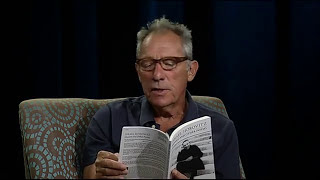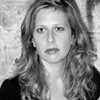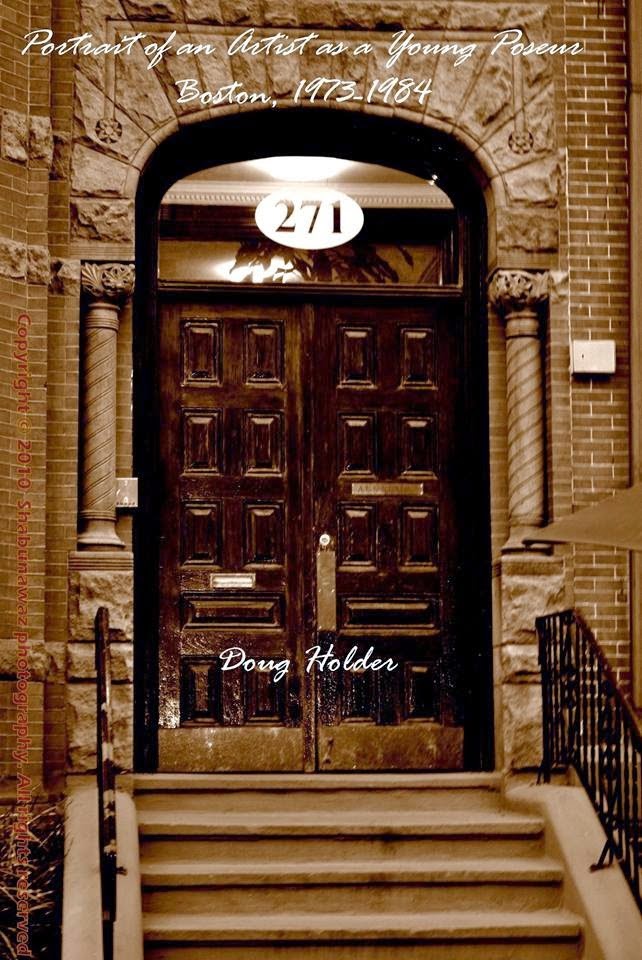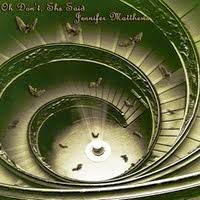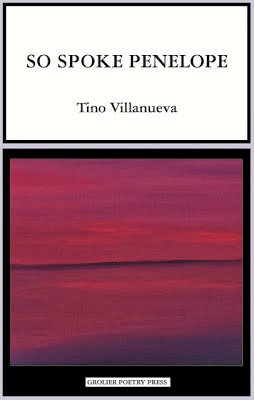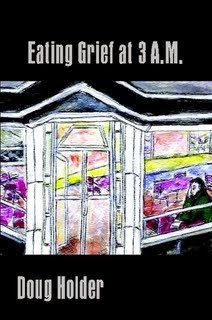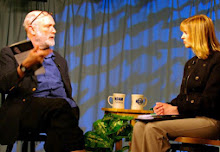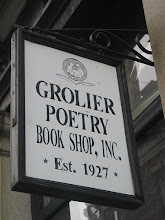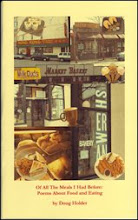Thursday, December 08, 2011
Exhibit of the Forking Paths By James Grinwis
Exhibit of the Forking Paths
By James Grinwis
ISBN: 978-1-56689-280-3
Coffee House Press
800-283-3572
info@coffeehousepress.org
$16.00
Review by Dennis Daly
Artistic forces channel through James Grinwis’s poems in a very unusual way. His book juxtaposes eighteen lined, near conventional poems with twenty-nine prose poems, each one a meditation on an electronic mechanism and the symbol of that mechanism. Both types of poems are heavy on imagery (sometimes surreal). The symbols are simplified but effective pictures of the electronics named, much like Chinese ideograms. Ezra Pound’s imagist theories and Ernest Fenollosa’s studies come to mind.
In the poem, Capacitor, a truck crashes into a wall, and behind that wall are men throwing javelins and thereby unburdening their hearts of violence. The stripped diagram of this action is the symbol for a variable capacitor. A capacitor’s function is to hold a charge, which in this case equates with violence.
In the very next poem the act of aggression is replaced with a defensive mechanism, Achilles shield, and that is ineffective. A man on a moped crashes through and a scene reminiscent of the movie, The Graduate, takes place. Then all are enveloped in a surreal mushroom cloud. Sound a little much. Well, it works. So I, for one, won't quibble.
Note that with javelins, shields, and later dinosaurs, and Aztec accoutrements the dimension of time is easily crossed. In fact in Halo with Bolt Through It, the poet, says, “Many dots coalesce and crawl together or make very small holes in space.” We’re talking worm holes here.
In Thermistor, the poet describes “entering a sphere and being spun about, shot up, shot down, flushed down a drain to emerge in one piece so wet, so new.” In other words, out the worm hole and into a parallel universe.
The poem Awry details more about one of these parallel universes,
Because there are five planets
holding themselves
against a huge bleached face
I write things.
Like hello, and
“I know you from somewhere.”
Cold as some of these images are, there is still some humor here. A Snap Switch springs under tension, joins currents. The narrative follows the snap switch’s diagram thus:
The arrows have struck one another, and the people are pulling
them apart. When he goes to the office, his tie never fits. Then she
whose belt is too large comes to him.
Also, in the Poem, Canine As A Kind Of Tooth,
Oversexed. Under
weather. Some say a microchip
embedded by an alien
is at the root of us.
a trainer of whippets,
a whippet-eer. Nobody being
nobody, she whispers
under her brainstorm.
Many of these poems are populated with ghosts. These figures not only personify the essential soul of an individual, but also the phantom double operating in another world. In Acknowledgement,
a glue stick of a ghost
an area beyond ghostliness
is it the stealth ghost
the one who stares while he moves
eats the legs of gazelles while she sleeps
The care and feeding of ghosts is dealt with in the revealing poem, Of Phantoms:
His face like a tooth blasted apart, though;
only a spike would mess with it.
Still, he is your phantom. Care for him
We must care for the things under our wings…
In Landscape Lento,
… The soul stares at its image in the ghost mirror.
A lantern glows vastly across the ghost mirror, which releases an
eerie whine backed by a far off organ grinder. There is an inter-
mezzo that creates itself and weaves its notes only for you, a
mingling of winds inside: the wind’s own ghost mirror:
Snow…
The poem, Condenser, which is defined as storing a charge, gives a gripping description of life in this mechanized world. Following the pattern of the poem’s symbol,
Four vehicles have taken off from parallel locations and soon pair off
toward an emptiness characterized by large white spaces unless, in
actuality, two pairs of vehicles as they approach one another diverge
and split off into parallel lonelinesses …
This book is not an easy read and certainly not for everyone. That said, once you get used to leaping from imagist construct to mechanist diagram, it becomes a real interesting poetic game, and a fun game at that.
Wednesday, December 07, 2011
Check Points By Michael Casey
Check Points
By Michael Casey
ISBN: 978-0-9838238-1-0
Adastra Press
16 Reservation Road
Easthampton, MA 01027
18.00
Review by Dennis Daly
At its core black humor usually camouflages a tragic reality. These poems by Michael Casey effectively make use of this type of humor, but do more than just camouflage. They provide a serious tool with which one can confront the horror of war, in this case the ill-conceived Vietnam War. The author’s technique allows us to see the logic of madness from inside out. The poem, bolo, cleverly explains,
the captain asks me
were you aiming to shoot
the pistol out of that guy’s hand?
And I said
fuck no, sir
I was aiming
for the finger I shot off.
In another poem entitled Chicom a demolition expert is asked for a favor—to defuse a grenade so that it could be used as a souvenir. The ordinance guy
.. said sure
and tried to pull
the bamboo tube
out of the serrated metal cone
it didn’t work
so he started banging the grenade
viciously against the corner of the jeep.
Fragging, the killing of your own officers, is poetically dealt with here by infusing this definition with an outrageous potion of black humor. The logic in this humor is as inescapable as it is bizarre. The cause of this phenomenon is blurted out in the poem of the same name, Fragging:
…it’s entirely
from electromagnetic disturbances
in the atmosphere
like I’m dumb he yells out
sunspots sunspots.
Makes absolute sense, doesn’t it? Especially since the alternative reality makes no sense at all.
The gravitas of the book in total far outweighs the poignancy of any individual poems. In fact most of the poems need one another and become much better pieces in this context. A good example of this is the obvious character development of the narrator’s fellow MP, John Bagley. Each succeeding poem seems to color him in with more detail. In the title poem, Check Point, Bagley is no more than a punch line. He is a rule breaking MP, who gives the narrator a ration,
Bagley starts the shit
how he’s an MP too
what right I have
tell him what to do.
Then the narrator pounces,
the Captain ask me
make a head count of pees
leaving the LZ
so I point to Bagley
and say
one.
The poem, John John At Chu Lai Airport, paints more endearing qualities onto Bagley’s personality, as he deftly deals with the military bureaucracy using not a little wit,
so I wrote down
the reason I came to Bangkok
was
not the bus tours.
In Turnkey Bagley, Bagley brags how he caught US troops breaking into, not out of, POW security,
I caught them almost right away
from their laughing
which woke me up
just as soon as I heard it
if not earlier
The culmination of all of Bagley’s antics is reached in the poem, Army Commendation, when his character becomes an anti-hero of mythological proportions,
I was in country six months
when the entire unit
everyone in it received
an Army Commendation Medal
everyone but Bagley.
Of course a poetic character of this stature must accomplish some impossible deed with his super powers. Bagley does this by saving the narrator’s life in his own unique way. Says the poet,
… I was gonna go
I arrange for Bagley to wake me up
Bagley forgets all about me
and the theater is blown up
two separate charges
within fifteen minutes
I talk to Bagley at the hospital about it
he says
how’d that gook know
it was such a lousy movie.
Notice that the fact that Bagley is indeed in the hospital as a result of the bombing is glossed over as not worthy of mention, but is consistent with war-logic as portrayed by Casey.
After one of their comrades is killed (Cenerizio’s Service), Bagley copies the technique of another soldier to remove that thought from his head. The scene is both affecting and ironic at once. He hits his ear with a hand
slapping himself hard
and you know
I knew right away exactly
what he wasn’t thinking of.
In the same way we know all too well what Michael Casey is not saying about war’s unspeakable nature in this remarkable book of poems.
Monday, December 05, 2011
Richard Kostelanz: The Avant Garde at Brown University: 1960 (Excerpt only)
Richard Kostelanetz, the noted avant-garde writer, was kind enough to send this excerpt of an interview conducted at Brown University in 2004 to the Boston Area Small Press and Poetry Scene.
I
Richard Kostelanetz, born in New York City in 1940, went to Brown in 1958, graduating with honors in American Civilization early in 1962. He later did graduate work at Columbia University in American history and at King’s College, the University of London, as a Fulbright scholar, taking an M.A. at the former in 1966. Ever since, he has been an independent scholar/writer/media artist residing, until recently, in lower Manhattan. His work in various domains has been recognized with individual entries in Contemporary Poets, Contemporary Novelists, Postmodern Fiction, Baker’s Biographical Dictionary of Musicians, A Reader’s Guide to Twentieth-Century Writers, the Merriam-Webster Encyclopedia of Literature, Webster’s Dictionary of American Authors, The HarperCollins Reader’s Encyclopedia of American Literature, NNDB.com, and Britannica.com, among other distinguished compendia.
The interviewer, whose comments appear here in italics, was Sarah Bird, an undergraduate working with the radical cultural historian Paul Buhle in the American Civilization program at Brown University. She talked with Richard Kostelanetz in November 2004 after RK's lecture to the Coalition of Independent Scholars at the General Society Library in New York City. RK corrected and amended the transcript then and, with brackets, later.
I
The only remotely avant-garde entity on campus around 1960 was the college literary magazine that had been edited by the painter John Willenbecher just before I arrived. In its small office I met Bill Berkson, who left Brown only a few months after I arrived, later becoming a prominent poet and art critic on the West Coast, who remembers our meeting in the literary magazine office in a memoir that I found on the Internet and incidentally reprinted in my CD-Rom Intellectual Correspondence in the 21st Century (2005): “I can hear you now, in the Brunonia office, talking of Dissent, PR [Partisan Review], and other critical journals, of which at the time I knew not one thing.”
In my library is an impressive copy of Brunonia's Fall 1958 issue that contains contributions by Berkson, Richard Foreman, and myself, each of us presaging what we later became. While Bill has a critical review of "beat" poetry, Richard contributes not only a short play that he calls "a cartoon," but also an extended review of Bertolt Brecht's "epic opera," as he calls it, Mahagonny, which Richard was invited to direct decades later in Lille, France. (It didn’t happen, even after being fully prepared, for reasons beyond his control.) My own contribution to Brunonia is a witty aphoristic dictionary that presages the Dictionary I wrote in 1990 and rewrote a decade later. (This issue also has a stylistically unusual story by Peter Goldman, who briefly became an avant-garde filmmaker before doing something else.) May I wonder if other issues of Brunonia and its successors, not to mention undergraduate literary magazines anywhere, are so professionally prophetic?
I knew less Steve Overbeck, perhaps two years ahead of me, who, as S. K. Overbeck, was later a Newsweek cultural staff writer for a while. Only after graduating did I meet Harry Smith, who left Brown just before I came, but as publisher of a literary periodical titled Pulpsmith he became one of the few Brown alumni to publish me.
I took only one course with S. Foster Damon, a great teacher and a sort of underground avant-garde celebrity, whom I saw more off-campus, so to speak. An activist in the art and musical avant-garde dating back to the 1920s, he taught me an awful lot of useful stuff, especially how to be a professional, which is not quite the same thing as “how to write.” There was at Brown around 1960 no conscious political or artistic avant-garde or underground to any degree that Paul Buhle, a few years younger than I, understands the latter term from his own experience at Wisconsin—certainly not when I was there in the late fifties and early sixties. Paul edited an anthology of rich memoirs about the 1950s and 1960s in at the University of Wisconsin that I recall reading with envy [History and the New Left, 1991], because nothing comparable could be written about Brown during those years.
II
For my last three semesters at Brown I lived down Hope Street, next to a local library that became an historical society; that location was at the time really more off-campus than it appeared to be the last time I visited Brown—in the early 1980s. We lived on the edge of a Portuguese slum called Fox Point that was probably slummier then than now. And Foster Damon lived a few blocks away, at a parallel distance from the main campus, at 24 Thayer.
Who is Foster Damon?
Foster was an extraordinary man whom I hope is still remembered in some way or another at Brown. Do a Google search of his name now, and you’ll find a healthy number of references, thousands I think. His influence persists, even though he died decades ago. He founded the Harris Collection of poetry in the library, he knew avant-garde music, and he knew avant-garde literature. As an undergraduate at Harvard before World War I, he had co-founded with other students the Harvard Musical Review (1912-1916), which was meant to appreciate contemporary music ignored by their teachers. One partner in this Review was a man who went on to a more distinguished career, the composer Roger Sessions, whose daughter Elizabeth was my Most Significant Other for many years. Foster’s brother-in-law was the eccentric Boston poet John Brooks Wheelwright, who died too young, whose literary executor Foster became, whose poems are treasured to this day by John Ashbery, among others.
[Since this interview, Ashbery questioned in correspondence with me about New Directions waiting thirty years between announcing in 1939 and finally publishing Wheelwright’s collected poems in 1970, conjecturing that Foster might have been responsible for the delay, speculating further about Foster’s possible dementia. Knowing John, I replied that Foster was quite lucid in 1960-62, when I knew him best, if often pickled. John replied that the Wheelwright papers kept at Brown were a mess. I recalled that though Foster sorted American songs for the Harris Collection he wasn’t skilled at detailed archiving. I didn’t recall Foster discussing Wheelwright, though he often mentioned W.S.B. Braithwaite, who had anthologized Foster; but in 1960 I might not have recognized Wheelwright’s name. I speculated that perhaps publication had to wait for his wife Louise, Wheelwright’s sister, to return from institutionalization, as she did just before he died. Since he, not she, was the official executor, while they didn’t have children, my speculation was admittedly insufficient.]
Foster was important as well for publishing in 1924 the first big book on William Blake in America. In this respect, he influenced my wife-to-be, a Pembroker, who wrote her Columbia doctorate on Blake and, I’m told, gave her son by her next husband the first name of Blake. In the 1930s, Foster compiled a pioneering anthology of American Songs that subsequently influenced the musical compositions of his contemporaries Virgil Thomson and Aaron Copland.
Then roughly that same age that I am now—in his mid-sixties--Foster had been involved in various boys’ clubs in Fox Point, which was then a Portuguese slum behind Power Street. Ed Margolis, long an English professor in Staten Island, remembers that a decade before me Foster taught boxing to the Fox Point kids. Because his wife Louise Wheelwright had been institutionalized for many years, select local kids would become his house helpers. Some of them went on to careers at Brown, like Ernie Costa, who worked in the Brown library until he died young. Though Foster had more connection to Fox Point than I did, perhaps my experience there prepared me for my next address, which was a low-rent public housing project in Harlem, down the hill from Columbia University.
Dinner at his Thayer Street house once a week, first for me and then for both Bunny and myself, was central to our experience of “underground Brown.”
Were you already interested in the avant-garde when you were at Brown?
Not so consciously. I remember reading on my own initiative Harold Rosenberg's The Tradition of the New, which turned me onto the idea of the avant-garde, and then Roger Shattuck’s The Banquet Years. I must have reviewed the Rosenberg book for the undergraduate literary magazine because I received an appreciative letter from the publisher who a few years later did a book of mine. Foster told me a lot, as I said, about the American avant-garde, not only in literature but also in music.
Did you feel at that time that avoiding the Brown writing program was probably a wise move?
As a major yes, but not Foster Damon’s verse writing course for which I signed up, even though I had no ambitions to write poetry at the time and I didn’t much like Damon’s assignments, which required us to write poems in a succession of English verse forms from Beowulf to the present. [A half-century later, long since a devout radical formalist, I wish I could take it again.]
From Foster above all others I probably developed the intellectual ambition for always aiming to take my work to a higher level, to go where no one else has gone or would go, in my case not only in criticism but creative work and even in this interview I hope, much as he and Cummings did in their own careers. Remember that Foster’s big book on William Blake, published in 1924 when Foster was only thirty-one, achieves an extraordinary unraveling. Check it out sometime to be impressed even now by his powers of elucidation, defining clarity in literature that previously seemed inscrutable. Foster would tell that when he was a graduate student in English lit at Harvard in the early 1920s, supplicants were asked what they thought of William Blake. It was enough for the student to say, “Oh Blake, he’s crazy,” for the examiner to move onto another subject. Simply, Foster’s Blake wasn’t crazy, and he’s not been crazy since. When I edited a decade ago an anthology of the more radical Cummings writings, it was appropriate to dedicate that book to Foster. From him and from the Brown history professor Bill [William G.] McLoughlin, as well as other intellectual heroes, such as George Orwell, whom I also discovered in college, also comes the ambition to tell the truth, even an unfamiliar truth, much as I hope to do here.
Though David Kelly continued to major in creative writing, I realized, partly through observing David’s experience, that I should stay away from other Brown writing courses, which I now think were designed to make high school teachers. I have a vague recollection of John Hawkes telling me in my freshmen year that I had “no talent for prose.” Since he dismissed me, I had no reason to take any other courses with him, probably to my good fortune, we could now judge. I must have kept in touch with Hawkes nonetheless because I remember taking him and his wife Sophie to dinner at Foster Damon’s. They hadn’t met before, even though they were Harvard undergraduates thirty years apart. Should we be surprised that Hawkes never contacted me after my graduation, though, need I say, as an alumnus publishing both fiction and fiction criticism that are recognized in histories and encyclopedias. If he mentioned my work or even my name to later Brown students, I’ve never heard about it. Should this be considered another sign of Brown professors’ lack of respect for their more successful students? I remember a close relative of his telling me, perhaps two decades ago, that Jack “hated every minute” of teaching, which may have been true.
Some alumni writers a generation younger than I have acknowledged John Hawkes’s importance to their development. One of them, whom I’ve not met, Jeffrey Eugenides, even successfully appropriated the Hawkes formula of a narrator whose physical abnormalities give him a peculiar perspective on experience. Perhaps by Eugenides’ time Hawkes became more respectful of his better students, not to mention his teaching talents, and thus a more effective writing teacher.
Probably because Hawkes and Edwin Honig didn’t get tenure at Harvard, where they had previously taught, they assumed that even their stronger students were likewise Harvard rejects, as indeed we probably were, though that stigma didn’t disqualify us finally from literary careers.
David Kelly, at any rate, went on to get an Iowa MFA writing degree and is now [was, alas] a prominent West Coast editor, whose book on Secrets of the Old Growth Forest (1990) won an award from northwest booksellers.
******** Kostelanz has an ebook BROWN UNIVERSITY REMEMBERED (Amazon Kindle)
Richard Kostelanetz
1051 Wyckoff Avenue
Ridgewood-SoHo, NY 11385-5751
646-524-3462 tel
718-559-6926 fax
www.richardkostelanetz.com
c 2011 Richard Kostelanetz
Sunday, December 04, 2011
“The Dangerous Islands” (a novel) by Séamas Cain
“The Dangerous Islands” (a novel) by Séamas Cain
The Red Jasper press (The.Red.Jasper.gmail.com)
Kit Fryatt, Curator
26D Saint Brigid’s Road Lower, Drumcondra
Dublin 9, Ireland
--review by Tomas O’Leary—
This book by the Irish writer Séamas Cain poses a serious challenge to the intellectual,aesthetic, philosophical, physical, metaphysical and omni-forbearing wherewithal of a humbly attentive Irish-American poet who’s been entrusted with the task of layingout words in more or less cogent rows, by way of a review that might entice the astute and expansive would-be reader to give it a shot, thereby perhaps expanding even further his or her grasp of the endless battle of language to transcend itself and discover on the far side whatever must otherwise remain quite inaccessible to mortal fiddlesticks who demand of narrative at least some comforting hint which allows them to think from time to time that they know where they are in the long run of the story.
Having just read “The Dangerous Islands” and felt its formidable powers of image
and metaphor, of concepts somehow simultaneously both boggling and elucidating,
of characters who waft wraithlike in and out of plotless conditions wherein they are
rendered pensive or foolish or transubstantiated or bludgeoned or flayed, all in the
undeniable service of metaphor, I confess: I still don’t know where I am.
At sea or not, however, I very much admire the author’s tenacity of vision as he drives his rough beast toward its final watering hole, which reads thus:
‘The Lady O’Handrahaun was singing: “I thought of gems, from gems, antimony,
lotus fringed.” Frank urinated, soundless on the needle-pad, since Jane purged
insects and gems from a lion. The Lady O’Handrahaun arose in the misted sun,
the rainbow sun, bore the sun as weight that binds the transposed cosmic spheres.
Lions were painted as if crouched before the entrance of a chapel. They came to
light in the wide-open snarling night, jaws like red granite. Jane exhaled a cloud of antimony on needle-pads. The mountain was quiet, the snake could not move.
Jane gormandized with lions on the snake. A heavy wagon rumbled by red peonies,
and red insects quivered.’ THE END
The book is presented as (a novel) parenthetically. I would say it IS a novel (paren-thetically) – a heroic 240-page conceit of persistence or insistence transcribed from
the (parenthetical) mind of its creator, whose opening 22 pages serve as first-person manifesto which presents a romp of clowns who manifest the psyche in its throes of deliberation, creation, argumentation and all such ations as may kindle in the reader a fire to fathom what in hell is striving to be born here. Here then a handful of phrases snatched with haphazard intentionality from those pages:
‘I seek form and wait the mold, amorphous and unrealized possibilities, fecundity, fruition. Illusion is the precondition of creativity.’
‘Philosophy must become composition of line and curve. There is a secret delerium in my teeth. I have the illusion of unlimited extent, arbitrary.’
‘Aesthetics is my god. My rugged sides become heated, ripened fruit, rocks and
leaves, sunlight, sleek hides of animals, coloured flowers. All words must be
physical and tangible.’
Then too there are the Troubles, all in metaphor, ethereally poignant, bloody, soul-
searching, sometimes even humorous in way of word play or grotesquery of image:
that seething, writhing reservoir of infinitely mutable images sufficient unto the
writer, the sculptor, the painter, or any harbinger of the imagination’s game reach
beyond itself: Northern Ireland. And yes, there are characters, Frank and Jane and
Alan and Harry, and others as well most surely, but the one that rises up in all her
spectral substance., to bless the novel’s realm with shades of evil, is one called
the Lady O’Handrahaun, of whom it comes to be written:
‘The “there-is” of the Lady O’Handrahaun has no literary or novelistic being, and thus it guarantees, for any ideal novelistic being, the efficacy of its presentational function, its structuring function, which spills and splits, before and after its
effect, the ungraspable plethora, the somnambulistic plethora of being, from the
thinkable cohesion of the reign of number and image over effective literary
situations. Arpeggios hover over the religious paintings of old masters. Forms
float above the urine of a virgin.’
But my pickings, what can they serve of this strange book at large? Minute glimpses,
I’d say, of whatever it is I have seen there. Chapter 16 addresses the notion of Novel and proffers as follows: ‘The Novel is a phallus pierced through by a needle. The Novel is a seagull resting on a pier at the end of the lake. What perfect voice will tell you the truth about my novel? The Novel must be there like the earth when shadow covers the wet grass. I would have liked to have been an otter.’
I wouldn’t mind being an otter myself at the moment, all play and to hell with
profundity, except as one dives deep for the uncomplicated joy of it. Séamas Cain’s
“The Dangerous Islands” is a work of serious genius. Whether or not it draws you
in for the long swim, I do recommend you test the waters and see.
Subscribe to:
Posts (Atom)






